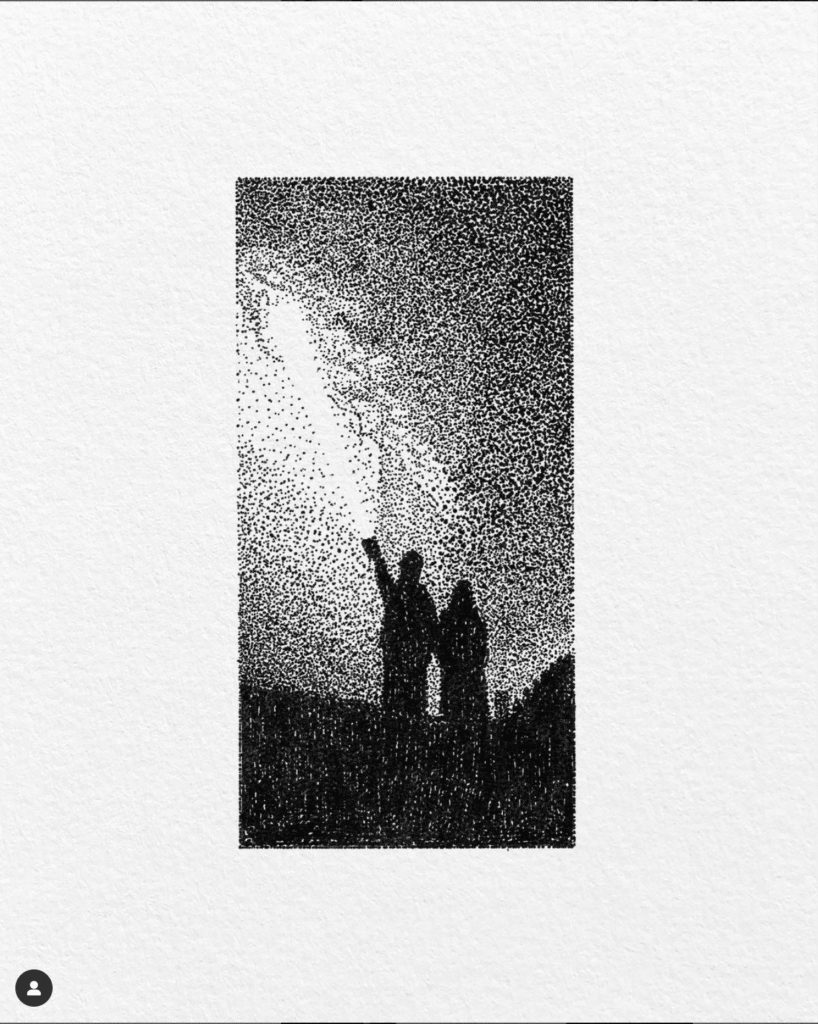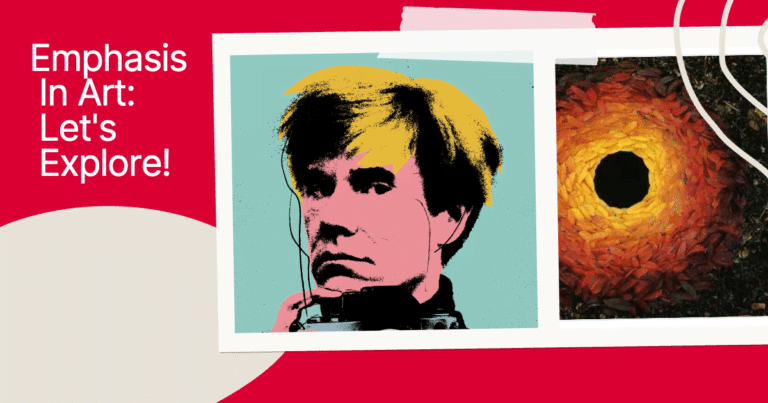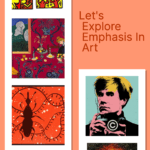Last Updated on September 21, 2023 by Dee
Emphasis in art is a powerful tool used by artists to create a focal point or draw attention to specific sections within a piece. It is one of the key principles of art and is used alongside the elements of art, which include color, form, line, shape, space, texture, and value. Emphasis can be achieved through various techniques, such as contrast, color, scale, placement, and repetition.
Understanding emphasis in art is essential for anyone interested in creating or appreciating art. By creating a focal point, artists can guide the viewer’s eye through the composition and create a sense of hierarchy.
Emphasis can also be used to evoke emotions and convey meaning. By highlighting specific elements, artists can create a mood, convey a message, or tell a story.
In this article, we will explore the role of emphasis in art, the different techniques artists use to create emphasis, and the emotional impact of emphasis. We will also look at historical examples of emphasis in art and answer some frequently asked questions about the topic.
Key Takeaways
- Emphasis is a key principle of art used to create a focal point or draw attention to specific sections within a piece.
- Emphasis can be achieved through various techniques, such as contrast, color, scale, placement, and repetition.
- Emphasis can be used to guide the viewer’s eye through the composition, create a sense of hierarchy, evoke emotions, and convey meaning.
Understanding Emphasis in Art

Fundamental Concepts
Emphasis is a principle of art that refers to the use of visual elements to draw attention to a certain area, usually a focal point, in an artwork.
It is an important concept in art that helps artists create a sense of importance and hierarchy within their compositions. Emphasis can be achieved through several techniques, such as contrast, color, scale, placement, and repetition.
The focal point is the area or object in an artwork that the artist wants the viewer to focus on first. It is usually the most important element in the composition and is often emphasized through the use of contrast, color, or placement. The focal point can be a person, object, or even a specific area within the composition.
Contrast is the difference between two or more elements in an artwork. It can be achieved through the use of color, value, texture, or size. Contrast helps create visual interest and can be used to emphasize certain areas or objects within the composition.
Role of Emphasis in Art

Emphasis plays a crucial role in creating a successful composition in art. It helps guide the viewer’s eye through the artwork and creates a sense of hierarchy and importance within the composition.
By emphasizing certain areas or objects, the artist can create a focal point and draw the viewer’s attention to the most important elements in the composition.
Emphasis can also be used to create a sense of movement or direction within the composition. By placing emphasis on certain areas or objects, the artist can create a flow that leads the viewer’s eye through the artwork.

Elements and Principles of Art
Visual Elements
Artists use a variety of visual elements to create their works. These elements include:
- Line: A continuous mark made on a surface.
- Color: The hue, saturation, and brightness of an object or area.
- Value: The lightness or darkness of a color.
- Texture: The surface quality of an object or area.
- Shape: A two-dimensional area with a defined boundary.
- Form: A three-dimensional object with height, width, and depth.
- Space: The area between and around objects.
Each of these elements can be used to create a variety of effects in a work of art. For example, lines can be used to create movement and texture can be used to create depth.
Principles of Art
In addition to the visual elements, artists also use a set of principles to guide their work. These principles include:
- Balance: The distribution of visual weight in a work of art.
- Movement: The visual flow of a work of art.
- Unity: The harmonious relationship between the visual elements in a work of art.
- Variety: The use of different visual elements to create interest and contrast.
- Proportion: The relationship between the size of different elements in a work of art.
- Rhythm: The repetition of visual elements to create a sense of movement.
- Harmony: The use of similar visual elements to create a sense of unity.
By combining these principles with the visual elements, artists can create works that are visually appealing and meaningful. For example, using balance and proportion, an artist can create a sense of stability and order in a work of art.
Emphasis Techniques in Art

Emphasis is an essential tool in creating a focal point in art. It is the technique of drawing the viewer’s attention to a specific area or object in the artwork.
There are several techniques used to apply emphasis in art, including the use of color and contrast, size and placement, line and texture, detail, and repetition.
Use of Color and Contrast
One of the most effective ways to create emphasis in art is through the use of color and contrast. Bright colors and complementary colors can create a strong contrast that draws the viewer’s attention to a specific area or object in the artwork. Shadow and high-key colors can also be used to create contrast and emphasize certain areas in the artwork.
Size and Placement
Size and placement are other techniques used to apply emphasis in art. By making an element larger than the others, the artist can create a focal point that draws the viewer’s attention. The placement of an element can also create emphasis by positioning it in the foreground or center of the artwork.
Line and Texture
Line and texture are also effective tools used to apply emphasis in art. Thick paint and strong, bold lines can create emphasis and draw the viewer’s attention to a specific area or object in the artwork.
Texture can also be used to create visual emphasis by adding a tactile quality to the artwork, making the emphasized area stand out from the rest.
Detail and Repetition
Detail and repetition are other techniques used to create emphasis in visual art. By adding intricate details to a specific area or object, the artist can draw the viewer’s attention to that area. Repetition of a specific element can also create emphasis by creating a pattern that draws the viewer’s attention.
Role of Emphasis in Composition

Emphasis is one of the most important principles of composition in art. It refers to the use of certain elements or areas in a work of art to create a focal point or center of interest. If an artist creates emphasis in an artwork, they can guide the viewer’s eye through the artwork and create a sense of visual hierarchy.
Focal Points and Visual Balance
Focal points are the areas of an artwork that draw the viewer’s attention. They can be created using various techniques such as contrast, color, scale, and placement.
By creating a focal point, artists can establish a sense of visual balance in their composition. Visual balance refers to the distribution of visual weight in an artwork.
By creating a focal point, artists can offset the visual weight of other elements in the composition and create a sense of equilibrium.
Unity and Variety
Emphasis also plays a crucial role in creating unity and variety in an artwork. Unity refers to the sense of oneness or wholeness in a composition. By creating a focal point, artists can establish a sense of unity by tying together various elements in the composition.
Variety, on the other hand, refers to the use of different elements to create interest and diversity in a composition. By creating emphasis on certain elements, artists can create variety and add visual interest to their artwork.
Proportion and Scale
Emphasis is also important in creating a sense of proportion and scale in an artwork. Proportion refers to the relationship between different elements in a composition, while scale refers to the size of the elements in relation to the overall composition.
By creating emphasis on certain elements, artists can establish a sense of proportion and scale in their artwork.
Emotional Impact of Emphasis

Emphasis in art is not just about creating a focal point, but it can also have a significant emotional impact on the viewer. By directing the viewer’s attention to a specific element, artists can evoke different emotions and reactions.
For example, a painting with a dark, shadowy figure in the foreground can create a sense of fear or unease in the viewer. Similarly, a bright, colorful object in the center of the canvas can evoke feelings of joy and happiness.
Emphasis can also be used to convey a sense of movement or action. By highlighting certain elements in a painting, an artist can create a sense of motion or direction, which can add to the emotional impact of the artwork.
In addition, emphasis can be used to convey a message or theme. By directing the viewer’s attention to a particular element, an artist can communicate a specific idea or concept.
For example, a painting with a prominent red cross can be interpreted as a commentary on healthcare or medicine.
Historical Examples of Emphasis in Art
Emphasis is a fundamental element of art that has been used by artists throughout history to create focal points and draw attention to specific sections within a piece. In this section, we will explore some historical examples of emphasis in art, including Renaissance, Impressionist, and Modern art.
Renaissance Art

During the Renaissance period, artists like Leonardo da Vinci used emphasis to create depth and balance in their paintings. One of the most famous examples of emphasis in Renaissance art is “The Last Supper” by Leonardo da Vinci.
In this painting, da Vinci uses implied lines and proportions to draw the viewer’s attention to Jesus Christ, who is the focal point of the painting.
Impressionist Art

Impressionist artists like Claude Monet and Berthe Morisot used color saturation and complementary colors to create emphasis in their paintings. “Impression, Sunrise” by Claude Monet is a prime example of emphasis in Impressionist art.
In this painting, Monet uses vivid orange to draw the viewer’s attention to the sunrise, which stands out from the weak blues, greens, and grays in the background.
Modern Art

In the 20th century, artists like Andy Warhol and Valentin Serov used emphasis to create bold and striking works of art. Warhol’s “Convergence” is a prime example of emphasis in modern art.
In this painting, Warhol uses repetition and saturation to draw the viewer’s attention to the center of the painting, where the colors converge.
Other modern artists like Andrew Wyeth, John Singer Sargent, Giovanni Boldini, Joaquín Sorolla, and George Inness also used emphasis to create powerful and emotional works of art.
By using different elements of art like color, direction, and placement, these artists were able to create focal points and draw the viewer’s attention to specific sections within their paintings.




